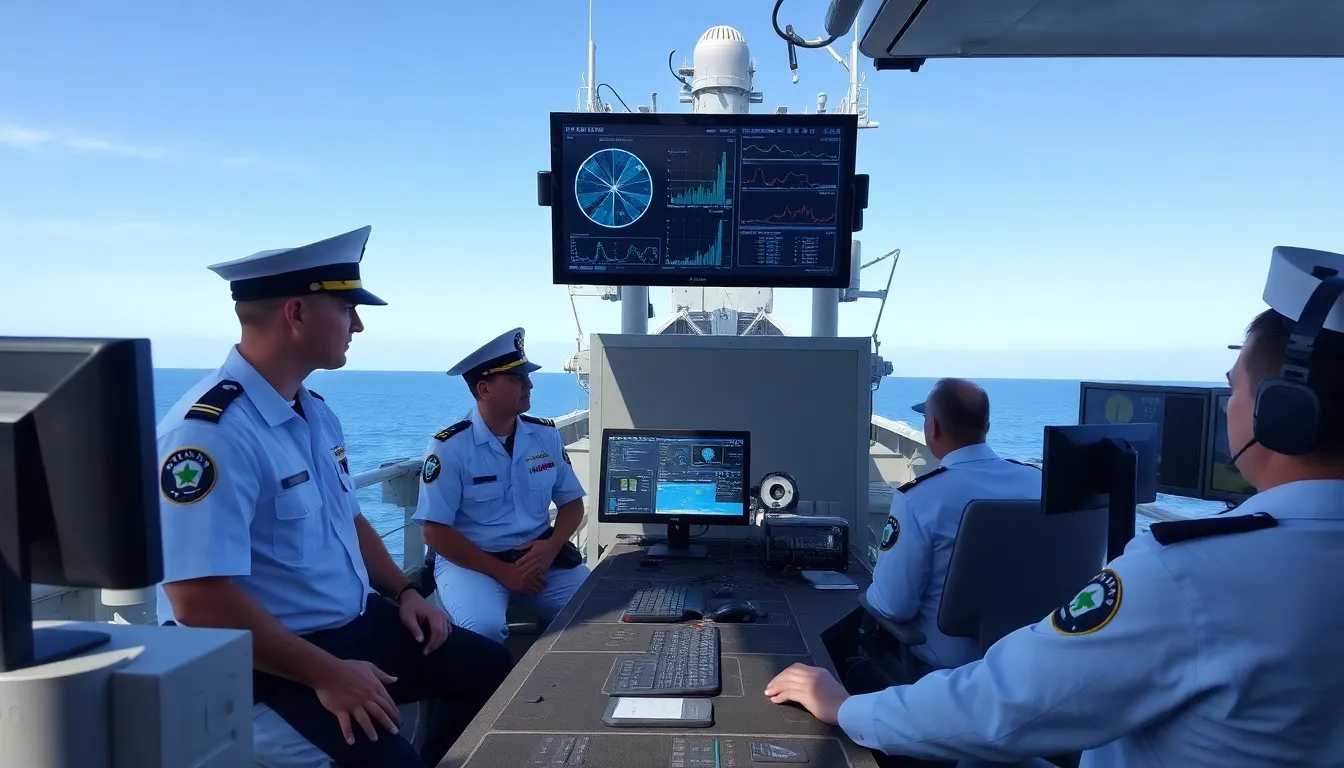In today’s digital battlefield, the U.S. Navy is not just sailing the seas but also navigating the treacherous waters of cyberspace. With high-speed internet as their trusty vessel, they’re on a mission to safeguard sensitive information and maintain operational superiority. Imagine a fleet of sailors zooming through the web like it’s a high-speed chase, all while keeping cyber threats at bay.
But it’s not all fun and games. With great speed comes great responsibility. The Navy’s cybersecurity strategies are as crucial as their naval tactics. They’re not just protecting data; they’re ensuring national security. Dive into the world where high-speed internet meets cutting-edge cybersecurity, and discover how the Navy is staying one step ahead of cyber pirates and hackers. After all, in the age of information, it’s not just about being fast; it’s about being smart too.
Table of Contents
ToggleOverview of Cybersecurity in the US Navy
Cybersecurity in the U.S. Navy plays a crucial role in maintaining national security. Protecting sensitive information requires advanced strategies and innovative technologies. High-speed internet facilitates rapid data transmission, enabling effective response to cyber threats.
The Navy continuously invests in cybersecurity initiatives. These initiatives include robust training programs for personnel and state-of-the-art defense systems. Information assurance remains a top priority for safeguarding operations. Integrated systems work cohesively to protect classified networks from intrusions.
Regular assessments identify vulnerabilities within the Navy’s cyber infrastructure. Risk management frameworks address threats while enhancing resilience. By employing cutting-edge encryption methods, the Navy ensures data integrity and confidentiality. Timely updates to software applications further strengthen defenses against evolving cyber risks.
Collaboration with federal agencies and private sector entities enhances threat intelligence sharing. Multidisciplinary teams operate in concert to monitor and mitigate cyber incidents. Operational readiness depends on a proactive approach to cybersecurity.
A culture of cybersecurity awareness among all service members amplifies defense efforts. Continuous education fostered through workshops and seminars keeps personnel informed about emerging threats. Information sharing and strategic partnerships significantly contribute to the Navy’s overall cybersecurity posture.
As cyber warfare tactics become more sophisticated, the Navy adapts its strategies accordingly. Ensuring information superiority requires agility and foresight. The onus lies not just on technology but also on well-trained personnel to navigate the complexities of cyberspace effectively.
Importance of High-Speed Internet for Naval Operations

High-speed internet serves a vital role in the effectiveness of naval operations. It directly impacts communication, data transmission, and overall operational efficiency.
Enhancing Communication Efficiency
Communication remains crucial in military environments. High-speed internet enables seamless communication among naval personnel across various locations. It supports video conferencing and real-time exchanges, ensuring strategic coordination. Prioritizing quick and reliable communication fosters teamwork and decision-making, particularly during missions. Enhanced connectivity allows for swift information dissemination, improving situational awareness among crew members.
Supporting Real-Time Data Analytics
Real-time data analytics significantly bolsters operational capabilities. High-speed internet facilitates the rapid collection and analysis of critical information. It enables the Navy to process vast amounts of data quickly, identifying patterns and potential threats. Utilizing advanced analytics improves decision-making processes, providing insights that drive strategic initiatives. Additionally, effective real-time data management increases the Navy’s agility in responding to emerging challenges in cyberspace.
Cybersecurity Challenges Faced by the US Navy
Cybersecurity challenges significantly impact the U.S. Navy, especially regarding high-speed internet networks. Safeguarding these networks is essential for maintaining operational integrity and national security.
Threats to High-Speed Internet Networks
Cyber threats targeting high-speed internet networks include sophisticated attacks like DDoS, phishing, and ransomware. Hackers exploit vulnerabilities to disrupt communications and data transfers affecting naval operations. Increased bandwidth creates larger attack surfaces, drawing more attention from cybercriminals. Ransomware incidents can paralyze systems, demanding payment for data recovery. Additionally, malware that infiltrates networks can lead to unauthorized access and data breaches, threatening classified information. Regular monitoring and a proactive approach are crucial to counter these threats and maintain secure internet usage.
Vulnerabilities in Naval Systems
Naval systems present several vulnerabilities that adversaries may exploit. Outdated software and hardware increase susceptibility to cyberattacks. Lack of software updates leaves critical systems exposed to exploitation. Remote access capabilities, while convenient, can introduce weaknesses that hackers can manipulate. Additionally, human error poses significant risks through phishing attacks or unsecured devices. Strengthening network defenses is imperative to address these vulnerabilities. Comprehensive training programs ensure personnel are aware of potential risks and security protocols. Prioritizing system audits and risk management frameworks fortifies the Navy’s cyber infrastructure against threats.
Implementation of Cybersecurity Measures
The U.S. Navy emphasizes robust cybersecurity measures to protect high-speed internet networks. Ensuring security involves stringent protocols and continuous monitoring.
Best Practices for Securing High-Speed Internet
Utilizing firewalls to filter unwanted traffic forms the first line of defense. Encrypting sensitive data helps maintain confidentiality and integrity during transmissions. Regular software updates minimize vulnerabilities by patching known security gaps. Conducting vulnerability assessments identifies and mitigates potential weak points in network architecture. Employing multi-factor authentication adds an additional layer of security against unauthorized access.
Role of Training and Awareness Programs
Training personnel cultivates a culture of cybersecurity awareness. Continuous education keeps service members informed about evolving threats. Workshops and seminars provide hands-on experience with security protocols and best practices. Developing incident response strategies prepares teams to act swiftly during cyber incidents. Encouraging open communication about security concerns fosters a proactive approach to managing risks.
Future Trends in US Navy Cybersecurity
Emerging technologies play a crucial role in shaping the U.S. Navy’s cybersecurity strategies. Artificial intelligence increasingly assists in threat detection and response, enabling rapid analysis of potential cyber threats. Machine learning algorithms provide insights into unusual patterns, enhancing situational awareness across networks.
Cloud computing also influences cybersecurity dynamics. The Navy harnesses its capabilities to bolster data storage and processing, allowing for scalable solutions that improve operational efficiency. However, with this transition, securing cloud infrastructure becomes paramount to protect classified information.
Blockchain technology emerges as a game-changer for information integrity. Utilizing decentralized ledgers can enhance data verification processes, ensuring authenticity across communication channels. Secure sharing of critical data relies on this innovative approach to prevent tampering.
Collaboration continues to be a cornerstone for the Navy’s cybersecurity evolution. Strong partnerships with federal agencies and private sector experts facilitate collective intelligence sharing, strengthening defenses against sophisticated cyber threats. Furthermore, engaging with academia allows the Navy to tap into the latest research and innovations in cybersecurity.
Regular training remains essential for personnel readiness. Ongoing education programs keep Navy members aware of current cyber threats and response strategies, fostering a proactive attitude towards cybersecurity. Enhanced simulations and tabletop exercises develop practical skills, equipping teams to handle real-world incidents effectively.
Vulnerabilities in emerging technologies demand continuous assessment. Conducting regular audits of systems ensures that potential weaknesses are identified and mitigated proactively. Through this vigilant approach, the Navy aims to maintain operational integrity while effectively navigating the complexities of high-speed internet environments.
The U.S. Navy’s proactive approach to cybersecurity in the realm of high-speed internet is essential for safeguarding national security. By investing in advanced technologies and robust training programs, the Navy is well-equipped to tackle the evolving landscape of cyber threats.
Their commitment to maintaining secure communications and operational efficiency reflects a deep understanding of the challenges posed by cybercriminals. As they continue to adapt to emerging technologies and foster a culture of cybersecurity awareness, the Navy stands ready to navigate the complexities of both cyberspace and the seas.
This dedication ensures that the Navy remains resilient against potential threats while enhancing its capabilities in a rapidly changing digital environment.








